Accepted Scientific Name: Sclerocactus spinosior subs. blainei (S.L.Welsh & K.H.Thorne) Hochstätter
Succulenta (Netherlands) 74(1): 43 (1995)

Sclerocactus spinosior subs. schlesseri Photo by: Peiffer Clement
Origin and Habitat: Sclerocactus schlesseriSN|19522]]SN|19522]] is a very rare cactus confined to the western USA. It occurs in Lincoln (and may be Nye County), Nevada; also in Utah (?). Possible or probable Nevada endemic. The population in Nye Co. is separated by more than 110 km from the colonies of Lincoln Co, but no intermediate plant colony are reported between this two localities. The number of wild individuals is very limited. In Lincoln County there are only 7 occurrences mapped at 1.0 km separation, or 13 occurrences mapped at 0.16 km separation; total estimated individuals 211, total estimated area 54.2 ha.
Altitude range: 1451-1568 meters above sea level.
Habitat and ecology: This species grows in open, stable or stabilized, gravelly, sandy silt or silty clay soils derived from somewhat ashy and/or gypsiferous lacustrine sediments, on mesic microsites created and/or maintained by gentle north to east aspects, dense shrub and/or grass canopies, high clay and silt content of the soil, and/or cryptobiotic soil crusts, usually associated with such soil crusts in the shadscale zone with Atriplex confertifolia, Gutierrezia sarothrae, Ericameria viscidiflora puberula, Krascheninnikovia lanata, Pleuraphis jamesii, Mentzelia albicaulis, Mimulus parryi, etc. This species is threatened by curtailment or destruction of soil crust and vegetation cover by recreational use, trampling by livestock or feral animals, off-road vehicle use, etc. It is also vulnerable to horticultural and hobby collection, some commercial or residential development, mineral exploration and development.
Synonyms:
See all synonyms of Sclerocactus spinosior
back
Accepted name in llifle Database:Sclerocactus spinosior (Engelm.) D.Woodruff & L.D.BensonCact. Succ. J. (Los Angeles) 48(6): 131. 1976 [May-Jun 1976]Synonymy: 6
Accepted name in llifle Database:Sclerocactus spinosior subs. blainei (S.L.Welsh & K.H.Thorne) HochstätterSucculenta (Netherlands) 74(1): 43 (1995)Synonymy: 8
back
Common Names include:
ENGLISH: Desert Valley Fishhook Cactus, Great Basin Eagle-claw Cactus, Schlesser's Pincushion
Description: Sclerocactus schlesseriSN|19510]]SN|19522]] is a spiny succulent with a more-or-less oval stem, 3-14 cm tall. Flowers are bright pink and funnel-shaped. Sclerocactus schlesseriSN|19515]]SN|19522]] is generally included within (as a synonym of) Sclerocactus blaineiSN|19522]]SN|19515]], suggesting that there is not really a fundamental difference between the two.
Habit: Ovoidal and generally solitary.
Stem: 3-15 cm tall.
Spines: Spines are pubescent in young and early reproductive plants; The central spine number varies, and the number of hooked spines may number as many as six, with one central more developed, papery sometimes flattened, ribbon-like and longer than in Sclerocactus spinosiorSN|19522]]SN|19510]].
Flower: Pink-purplish borne at the apex of the stem, blooming in late-spring (May-June).
(In cultivation in April )
Remarks: Red flowers are common in species pollinated by birds (but also bat and insect)
Subspecies, varieties, forms and cultivars of plants belonging to the Sclerocactus spinosior group
 Sclerocactus nyensis Hochstätter: has reddish spines that may or may not be hooked, central spines more numerous (six to eight), and more or less indehiscent fruit. Flowers rose-coloured in spring. Distribution: Nye and Esmeralda Counties, Nevada, USA.
Sclerocactus nyensis Hochstätter: has reddish spines that may or may not be hooked, central spines more numerous (six to eight), and more or less indehiscent fruit. Flowers rose-coloured in spring. Distribution: Nye and Esmeralda Counties, Nevada, USA. Sclerocactus spinosior (Engelm.) D.Woodruff & L.D.Benson: (subsp. spinosior) has lower central spines that are tan to black, and one upper central and 2 lateral central spines 2-6 cm long. Distribution: southwestern Utah (Beaver, Juab, Millard, Iron and Sevier Counties).
Sclerocactus spinosior (Engelm.) D.Woodruff & L.D.Benson: (subsp. spinosior) has lower central spines that are tan to black, and one upper central and 2 lateral central spines 2-6 cm long. Distribution: southwestern Utah (Beaver, Juab, Millard, Iron and Sevier Counties). Sclerocactus spinosior subs. blainei (S.L.Welsh & K.H.Thorne) Hochstätter: has, flat, white lower central spines. One upper central spine, 2 lateral central spines, and one lower central spine, 3.5-5.5 cm long (usually longer than subsp. spinosior). Distribution: Nevada (Nye County and Lincoln County)and Utah in the Escalante Desert (Iron County).
Sclerocactus spinosior subs. blainei (S.L.Welsh & K.H.Thorne) Hochstätter: has, flat, white lower central spines. One upper central spine, 2 lateral central spines, and one lower central spine, 3.5-5.5 cm long (usually longer than subsp. spinosior). Distribution: Nevada (Nye County and Lincoln County)and Utah in the Escalante Desert (Iron County).  Sclerocactus spinosior subs. schlesseri (K.D.Heil & S.L.Welsh) Hochstätter: is generally included within (as a synonym of) Sclerocactus spinosior subs. blainei, suggesting that there is not really a fundamental difference between the two. Distribution: Nevada, Lincoln County.
Sclerocactus spinosior subs. schlesseri (K.D.Heil & S.L.Welsh) Hochstätter: is generally included within (as a synonym of) Sclerocactus spinosior subs. blainei, suggesting that there is not really a fundamental difference between the two. Distribution: Nevada, Lincoln County.
Bibliography: Major references and further lectures
1) Heil, K. and S. Welsh. "New Sclerocactus (Cactaceae) from Nevada." Great Basin Naturalist 46: 677-678. 1987.
2) Heil, K. D. and J. M. Porter. "Sclerocactus (Cactaceae): a revision." Haseltonia 2: 20-46. 1994.
3) Hochstaetter, F. "Het geslacht Sclerocactus: een revisie 1." Succulenta 71: 247-262. 1992.
4) Hochstaetter, F. "Nieuwe combinaties in het geslacht Sclerocactus." Succulenta 74: 38-44. 1992.
5) Morefield, J. D. "Status report for Sclerocactus schlesseri Heil and Welsh (1987)." Carson City: Nevada Natural Heritage Program, prepared for the U. S. Fish and Wildlife Service and the Bureau of Land Management, Reno 1994.
6) Nevada natural heritage program.“Sclerocactus schlesseri Heil & Welsh - SCHLESSER PINCUSHION” Rare plant fact sheet. Compiled 25 June 2001 <http://heritage.nv.gov/sites/default/files/atlas/sclerschle.pdf> web 30 January 2016
7) Lincoln County Land Act Groundwater Development and Utility Right-of-way Project: Environmental Impact Statement 2009
8) David Hunt, Nigel Taylor “The New Cactus Lexicon” DH Books, 2006
9) Edward Anderson “The Cactus family” Timber Press, Incorporated, 2001
10) James Cullen, Sabina G. Knees, H. Suzanne Cubey "The European Garden Flora Flowering Plants: A Manual for the Identification of Plants Cultivated in Europe, Both Out-of-Doors and Under Glass" Cambridge University Press, 11/Aug/2011
11) J. Mark Porter in: "Endangered Wildlife and Plants of the World", Volume 2 Marshall Cavendish Corporation, 2001
12) Leo J. Chance “Cacti and Succulents for Cold Climates: 274 Outstanding Species for Challenging Conditions” Timber Press, 19 June 2012
13) J. Mark Porter in: "Endangered Wildlife and Plants of the World", Volume 2 Marshall Cavendish Corporation, 2001
14) “Sclerocactus blainei” in Flora of North America @ efloras.org <http://www.efloras.org/florataxon.aspx?flora_id=1&taxon_id=242415293> FNA Vol. 4 Page 204 . web 30 January 2016
15) Stephen Ingram “Cacti, Agaves, and Yuccas of California and Nevada” Cachuma Press, 2008
16) Butterworth, C. & Porter, J.M. 2013. Sclerocactus spinosior. In: IUCN 2013. "IUCN Red List of Threatened Species." Version 2013.2. <www.iucnredlist.org>. Downloaded on 14 February 2014.
 Sclerocactus spinosior subs. schlesseri Photo by: Valentino Vallicelli
Sclerocactus spinosior subs. schlesseri Photo by: Valentino Vallicelli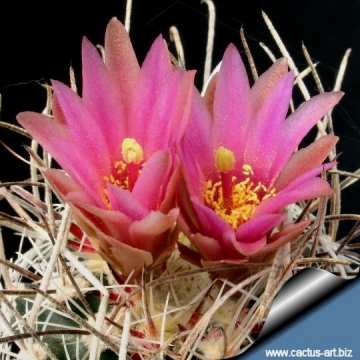 Sclerocactus spinosior subs. schlesseri Photo by: Cactus Art
Sclerocactus spinosior subs. schlesseri Photo by: Cactus Art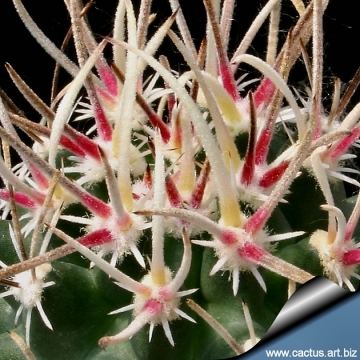 Sclerocactus spinosior subs. schlesseri Photo by: Cactus Art
Sclerocactus spinosior subs. schlesseri Photo by: Cactus Art Sclerocactus spinosior subs. schlesseri Photo by: Cactus Art
Sclerocactus spinosior subs. schlesseri Photo by: Cactus Art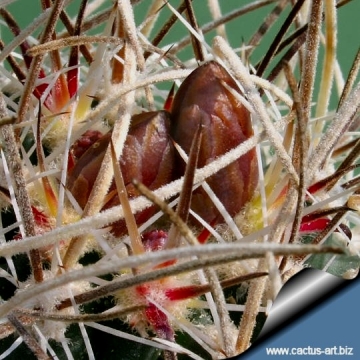 Sclerocactus spinosior subs. schlesseri Photo by: Cactus Art
Sclerocactus spinosior subs. schlesseri Photo by: Cactus Art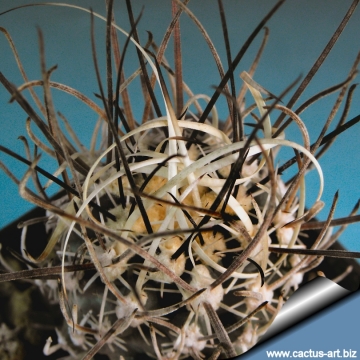 Sclerocactus spinosior subs. schlesseri Photo by: Cactus Art
Sclerocactus spinosior subs. schlesseri Photo by: Cactus Art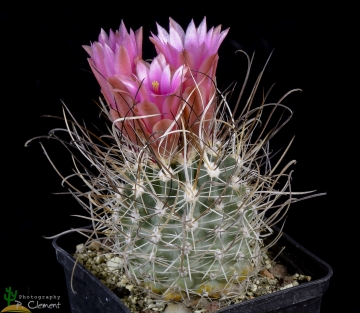 - Sclerocactus spinosior v. schleseri RP136 (Collector Ralph Peters) Lincoln, Nevada, USA. This species is one of the most beautiful in the genus it has wonderful spines: pubescent in young specimens, papery and somewhat flattened when adult. Photo by: Peiffer Clement
- Sclerocactus spinosior v. schleseri RP136 (Collector Ralph Peters) Lincoln, Nevada, USA. This species is one of the most beautiful in the genus it has wonderful spines: pubescent in young specimens, papery and somewhat flattened when adult. Photo by: Peiffer Clement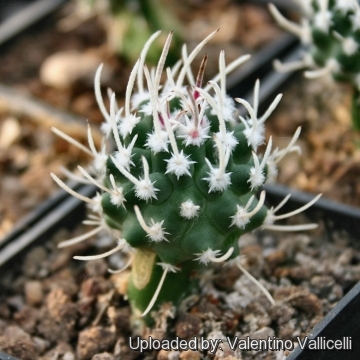 Sclerocactus spinosior subs. schlesseri Photo by: Valentino Vallicelli
Sclerocactus spinosior subs. schlesseri Photo by: Valentino VallicelliCultivation and Propagation: This plant is very rare in cultivation, it is difficult to grow on its own roots and to propagate. Mature individuals easily rot and die especially after planting. The seeds germinate with extreme difficulty and a low rate of success, seedlings do not do well either, and more die each year. Sclerocactus blaineiSN|19515]]SN|19515]] is extremely xerophytic and adapted to very dry soils, but plants grafted on hardy stock (Opuntia humifusaSN|11629]]SN|11629]], Echinocereus triglochidiatusSN|10576]]SN|10576]] etc...) are relatively easy to grow and no special skill is required, they can stay in a non heated green house. (min tem -20°C) ... This interesting cactus, continues to be a particular prize among specialist collectors.
Propagation: Seeds are extremely difficult to germinate (only 2-3 percent of seeds germinate). The germination is really difficult and if some seedling finally sprout, as they start to grows they disappear one by one. Grafting is often used to speed growth rate and to create a back-up for plants in collection.
Your Photos

by Valentino Vallicelli
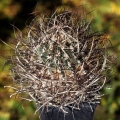
by Valentino Vallicelli

by Valentino Vallicelli
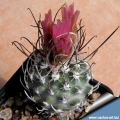
by Cactus Art
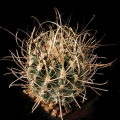
by Valentino Vallicelli
























